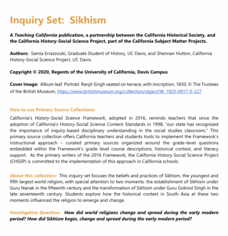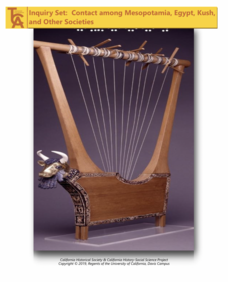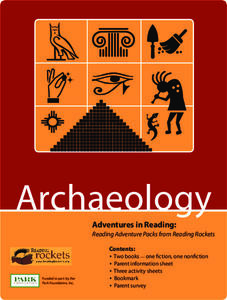Core Knowledge Foundation
Maya, Aztec, and Inca Civilizations
A 10-lesson unit explores the Maya, Aztec, and Inca civilizations. Over the course of two weeks, scholars read nonfiction excerpts, discuss their findings, and complete activities. An assessment equipped with multiple choice and matching...
University of California
Jewish Holidays
Modern Jewish holidays have ancient roots with many connections to today. Using photographs of primary sources, such as fragments of a shofar, as well as texts, such as the Hebrew Tanakh, learners explore how Jewish holidays reflect...
University of California
Sikhism
How does a new religion start? The informative resource highlights the Sikhism religion. Academics learn how the religion was created and spread throughout the ancient world. Scholars view a series of primary sources and complete a...
University of California
The Mongol Empire
Scholars review eight sources to learn about the impact of the Mongol Empire and their leaders, such as Genghis Khan. Academics learn how the Mongols destroyed states but also increased connections with the rest of the world. To finish,...
University of California
Interactions in Baghdad and the Abbasid Caliphate
An interesting resource focuses on the cultures of different peoples that have lived in Baghdad and their interactions. Academics view 11 sources to understand how Baghdad has been home to people of many faiths and cultures throughout...
University of California
Bread and Circuses: Rome as a Site of Encounter
An intriguing lesson uses 12 Roman artifacts to explain Roman society and politics. Young historians view images of artifacts and learn how each one represents an aspect of Roman society. Academics also complete a hands-on activity to...
University of California
Contact among Mesopotamia, Egypt, Kush, and Other Societies
Trade has always been a global affair. Explore what global trade meant for ancient Mesopotamians, Egyptians, and Kushites using a collection of documents from the historic societies. By examining literary works such as the Epic of...
PBS
Reading Adventure Pack: Archaeology
Readings of fiction and nonfiction texts followed by a series of activities put scholars in an archaeologist's shoes. Learners read two texts, Archaeologists Dig for Clues by Kate Duke and The Shipwrecked Sailor: An Egyptian Tale with...
Crabtree Publishing
The Genius of the Ancients
It is said that necessity is the mother of invention. Fifth graders prove this with help from three lessons that examine how ancient cultures used their needs to drive innovations. In lesson one, pupils identify main ideas and supporting...
New York State Education Department
Global History and Geography Examination: August 2012
Let's test global history knowledge. The standardized test, designed for high schooler scholars, assesses world history and geography. The assessment is divided into five different sections, including essay items and multiple choice. It...
New York State Education Department
Global History and Geography Examination: January 2012
Familiarize future test takers with the format of standardized tests. The assessment covers world history topics, such as the French Revolution and South American civilizations. It also covers world geography. The test, designed for high...
New York State Education Department
Global History and Geography Examination: August 2013
What test-taking strategies help individuals ace exams? The standardized test assesses scholars' knowledge of world history and geography. High school historians put their test-taking strategies to use in the multiple choice, document...
New York State Education Department
Global History and Geography Examination: January 2013
How much do high schoolers know about human history? The assessment covers global history and geography with multiple choice, document based items, and essay questions. It covers topics such as human migration patterns and religions of...
New York State Education Department
Global History and Geography Examination: August 2014
What does the class know about world history and geography? The assessment tests high school scholars' skills in a state standardized test from the New York Department of Education. It covers topics such as the Enlightenment and the...
New York State Education Department
Global History and Geography Examination: June 2012
Want to find out how much class members really know about history? A copy of a New York state test assesses scholars' knowledge of world geography and history in a multi-format test that includes multiple choice and essay items. The...
New York State Education Department
Global History and Geography Examination: June 2013
Is it time to improve test-taking skills? The assessment is a copy of a state test for pupils to practice strategies for taking exams. It covers subjects such as the Chinese Dynasty's and ancient Indian history. It is divided into...
New York State Education Department
Global History and Geography Examination: June 2014
Want to test pupils' knowledge of world events? The assessment addresses global history, such as the ideas of the enlightenment, trade, and geography in five different sections. Pupils answer multiple choice, document-based items, and...
Describing Egypt
Temple of Isis (Philae)
How did the Temple of Isis change throughout history? The resource discusses how architecture changed purposes over the time periods of the Pharaonic Era and the Greco-Roman Era. It gives a glimpse into what life was like and provides...
Describing Egypt
Horemheb - (18th Dynasty)
Who was Horemheb and why is his tomb so famous? An fascinating resource uses virtual reality tools and even comes equipped with the ability to use a VR headset. Learners view information panels to the side of the location to understand...
Describing Egypt
Sennedjem - (19th Dynasty)
Who was Sennedjem and how does he relate to ancient Egypt? The resource describes the artisan's life as well as the village in which he lived, called Set Ma'at. Learners view where the people who built the tombs for powerful Egyptians...
Describing Egypt
Ramesses VI - (20th Dynasty)
An interactive tour of the tomb of Rameses VI illustrates ancient Egypt's explanation of life with its intricate drawings and details. Dragging the mouse shows a 365-degree view of the tomb, and details about the meaning of each location...
Describing Egypt
Temple of Kalabsha (Temple of Mandulis)
What was the Kalabsha Temple to ancient Egyptians? Discover the importance of the dock and the use of bodies of water to the Egyptian people. The resource includes side panels with important information about the history of the location.
Describing Egypt
Ptah-Hotep and Akhet-Hotep Mastaba
Did you know that mastaba means bench in Arabic? Learn why a mastaba was so important to ancient Egyptian architecture. Middle and high schoolers alike stay entertained while reading a passage that describes the virtual tour of...
New York State Education Department
Global History and Geography Examination: January 2016
What do the Inca Civilization, Wittenburg Church, and India's economy in the Mughal Period have in common? The well-rounded standardized test challenges scholars to remember all of them. They use different graphics and maps to answer...

























